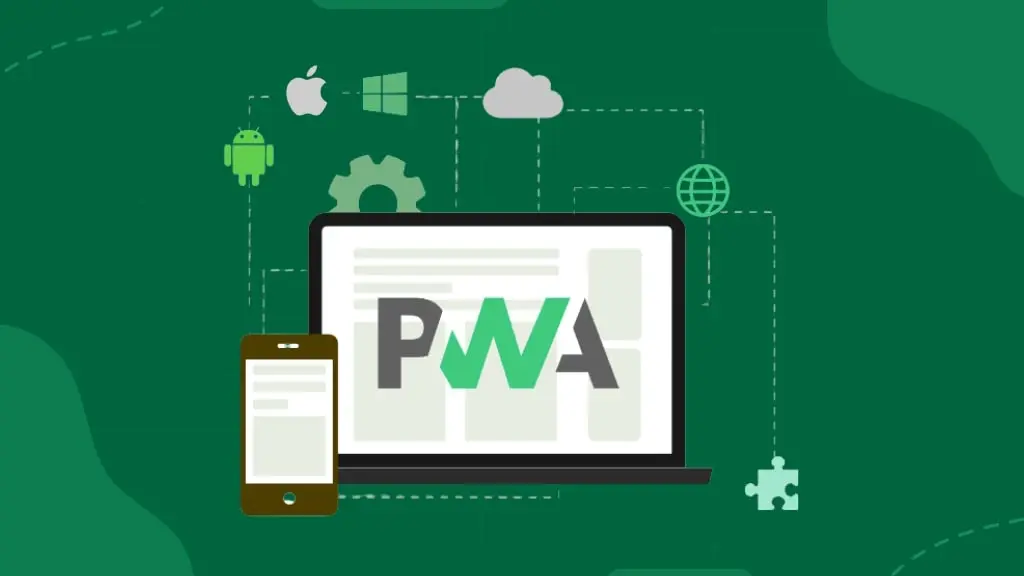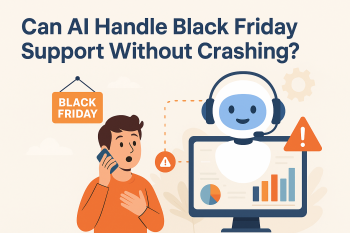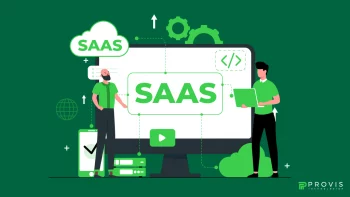With more than 33% of the world’s population(1) shopping online, eCommerce is now a $6 trillion industry and will soon reach the $8 trillion mark by 2027.
Now, it’s safe to say that e-commerce is growing exponentially. So, businesses are looking for different ways to enhance user experiences, increase engagement, and generate more revenue. Here, progressive web apps in e-commerce are making waves.
How?
By combining the features of web and mobile applications and revolutionizing how consumers interact with online stores. In this blog, we are going to explain how PWAs are transforming the e-commerce landscape.
What Are Progressive Web Apps For E-commerce?
PWAs, or progressive web apps, combine the best of web and mobile applications to deliver a seamless, app-like experience through web browsers. They are built using standard web technologies such as HTML, CSS, and JavaScript but offer features like native mobile apps, such as
- Offline access,
- Fast loading speed,
- Home screen installation, and more.
Benefits of Progressive Web Apps In E-commerce?
PWAs for online shopping are a game-changer as these provide a myriad of benefits. Below, we have listed a few!
● Works Offline
Reports (2) suggest that PWAs reduce abandoned shopping cart rates by up to 35%.
Read on to find out how.
Imagine a user browsing your e-commerce store and suddenly they lost their internet connection. There is a high chance you’ll lose that customer. Right?
But what if we tell you progressive web apps can help you retain that customer?
Wondering how?
With these apps, users can browse, view products, add items to their cart, and shop even without an internet connection.
● Sends Push Notifications
Another feature for progressive web apps in e-commerce is push notifications.
With these notifications, alerts about sales, new products, or special offers will be sent directly to customers. For instance, a notification about a “limited-time discount” or “50% off for 1 hour” will encourage them to make a purchase.
● Responsive Design
Whether your target audience is using a desktop, tablet, or smartphone, PWAs look and work great on any device. This ensures users can enjoy a smooth shopping experience regardless of the device they use.
● Easy Access
PWAs can be installed on a user’s home screen with just a few taps, without the need for an app store download. This ease of access increases the likelihood of customers returning to the store.
In a nutshell, users can add an e-commerce site’s PWA to their home screen and access it instantly with a single tap, just like a native app.
● Cost-Effective
Here’s a question:
What will cost less, the development of one progressive web app or separate native apps for different platforms (iOS and Android)?
The answer will be a PWA! This is the next benefit of progressive web apps in e-commerce.
Compared to native app development, PWA app development is cost-effective, ranging between $15.000-$50,000. So, an e-commerce business can launch a single PWA that works across all devices, saving on the costs of developing and updating multiple native apps.
● SEO-Friendly
PWAs are indexable by search engines (Google), which can improve the store’s search engine optimization visibility and increase organic traffic. This leads to more potential customers finding your online e-commerce store.
● Loads In The Blink Of An Eye
PWAs for online shopping are designed to load quickly, even on slow networks. Faster loading times lead to a better user experience and reduce the chances of users abandoning the site.
Don’t Miss: – How Will AI Affect the Design of UI/UX?
Progressive Web Apps PWA Trends in 2024
In 2024, several trends are expected in terms of progressive web apps in e-commerce. Read on to find out!
● AI and Machine Learning Integration
The integration of AI and machine learning algorithms will become more common in offering personalized shopping experiences to users. AI-driven recommendations, chatbots, and customer support will enhance user engagement and satisfaction, resulting in higher conversion rates.
● Voice Search and Commands
Voice search and commands will be added to progressive web apps with the growing popularity of voice assistants like Siri, Alexa, and Google Assistant.
Consumers will be able to search for products, add items to their cart, and complete purchases using voice commands. This will make the whole shopping experience more convenient and hands-free.
● Security Is Priority
Looking at the number of increasing cybercrimes in 2024, enhanced security measures will be a priority for PWAs. This includes better data encryption, secure payment gateways, and robust user authentication processes.
This way, the customer will feel more confident knowing their personal and financial information is protected.
● Augmented Reality (AR)
The next expected PWA trend in 2024 is the adoption of AR technology. This will allow users to virtually try on products or see how items look before making a purchase.
● Smarter Push Notifications
Push notifications will become smarter and more personalized according to user behavior and preferences. This will be done using data analytics to send targeted notifications that are relevant and timely, increasing user engagement and conversion rates.
Must Know:- Top 8 Programming Languages for Mobile App Development
Real-World Examples of PWAs in E-commerce
Not only small businesses but big giants are also leveraging the benefits of progressive web apps in e-commerce. Below are some of the real-world examples.
● Alibaba
Alibaba, one of the world’s largest online B2B marketplaces, adopted a PWA to improve the mobile shopping experience for its users. This resulted in:
- 76% increase in conversion rates across different browsers.
- 400% higher interaction rate with the “Add to Home screen” prompt.
- 14% increase in iOS monthly active users
- 30% increase in Android active users.
● Flipkart
Flipkart, a leading e-commerce site in India, developed a PWA called Flipkart Lite to reach users with unreliable internet connections. This move proved game-changing for the brand. The below numbers are proof! (3)
- 70% increase in conversions.
- Users spent 3x more time on site, i.e., 3.5 minutes ( Flipkart Lite) vs. 70 seconds (previous mobile app)
- 40% higher re-engagement rate
- 3x lower data usage
● Lancome
Lancôme, a luxury cosmetics brand, implemented a PWA to enhance its mobile shopping experience. Here’s what the results look like.
- Mobile sessions rise by more than 53%
- 17% increase in conversions
- Conversion rates on abandoned carts increased by 8%
- 10% bounce rate decrease among iPhone users
- Over 18,000 shoppers signed up for push notification alerts
● OLX
OLX, a global online marketplace for buying and selling goods and services, launched a PWA to improve user experience on mobile devices.
- Engagement increased by 250%, and a 146% increase in CTR (Click-Through Rate) on ads.
- 80% lower bounce rates
- Users benefit from offline functionality, leading to more time spent on the platform.
If you want your e-commerce business to be the next one on the list, hire app developers from Provis Technologies.
PWA Vs. Native Apps For E-commerce
Choosing between Progressive Web Apps (PWAs) and native apps for your e-commerce business can be a big decision.
Below, you’ll find a quick comparison between PWA vs. native apps.
| Parameter of Differences | Progressive Web App | Native Apps |
| Development | Built using web technologies (HTML, CSS, JS) | Built specifically for iOS or Android using different programming languages (Swift for iOS, Java/Kotlin for Android). |
| Maintenance | Easier and cheaper, updates are made on the server | Requires separate updates for each platform, which is more costly |
| Development Cost | Cost-effective | More expensive due to separate versions for each platform |
| Installation and Accessibility | Users can add PWAs to their home screen directly from the browser without going through an app store. | Must be downloaded and installed from the Apple App Store or Google Play Store. |
| Reach | Accessible by anyone with a web browser | Limited to users who app download from app stores |
| Features | Limited by browser capabilities, still offers advanced features like push notifications and offline access. | It can fully utilize all device features (camera, GPS, Bluetooth, etc.). |
By analyzing the differences, you’ll be able to make an informed decision about whether a PWA or a native app will be right for your e-commerce business.
Related Blog: – Top 10 Mobile Usability Issues and Solutions to Fix Them
Conclusion
With fast loading speed, home screen access, and a seamless user experience, PWAs in e-commerce have it all. They offer a seamless, fast, and engaging user experience that meets the high expectations of modern consumers.
So, what are you waiting for?
Get in touch with our team, and we will help you build a progressive web app for your e-commerce business.
Frequently Asked Questions (FAQs)
1. What are the benefits of PWA for eCommerce?
PWAs offer several benefits to e-commerce businesses, including
- Faster loading times,
- Improved performance,
- Offline capabilities, and
- Easy installation without the need for app stores.
These features lead to better user engagement, higher conversion rates, and increased customer satisfaction.
2. Can PWAs be used on any device?
Yes, PWAs are designed to work on any device with a web browser, including desktops, tablets, and smartphones.
References:
Written By
Author's Picks
- A Complete Guide to Different Types of E-commerce Solutions
- 14/02/2025
- The Role of Mobile App Development in Boosting E-commerce Sales
- 10/11/2024
- Top Wix eCommerce Features for your Online Store
- 18/12/2024
Categories
- AI for Startups
- AI in Web Development
- AI Integration
- AI Platforms
- AI Prompt
- AI Tools
- AI Trading Software
- Android App
- Android vs iOS Development
- Angular
- API
- API Development
- App
- app development
- App Idea
- App User Feedback
- Application
- Artificial Intelligence
- Audit Services
- Automotive Industry
- Awards and Recognition
- Business Consulting
- Business Website
- Chatbots
- CRM
- CRM for Financial Advisors
- Custom CRM
- Custom SaaS
- Custom Website
- Customer Service
- dashboard design
- Developing a Mobile App
- Digital Business
- E-commerce
- EMR Integration
- Finance
- Financial Advisors
- Financial Advisors
- GIT
- Health Insurance
- iOS App
- iOS App Development
- IoT Mobile App Development
- IoT Platforms
- IT Audit Services
- IT Consulting
- IT Strategies
- Java Development
- Laravel
- Lean Canvas
- Learning Management System
- Logistics Apps
- Mobile App Development
- MVP
- Native App
- News Aggregator Site
- OTT
- Outsourcing IT
- Payment Gateway
- predictive analysis
- Product Launch Strategy
- Progressive Web App (PWA)
- Prototype
- Recommender Systems
- Ruby
- SaaS
- SaaS Application
- SaaS Business
- SaaS Company
- SaaS Development
- SaaS Product
- SaaS Project
- Sales Funnel
- SEO
- Shopping Cart
- Software Development
- SSL and TLS
- Startup Checklist
- Technology
- Tetradic Color Scheme
- UI/UX Design Company
- Unit Testing
- User Flow
- User Testing
- Web Development
- Web Performance Optimization
- website Maintenance Services
- Website Migration Service
- Website Speed Optimization
- WooCommerce
- WordPress





